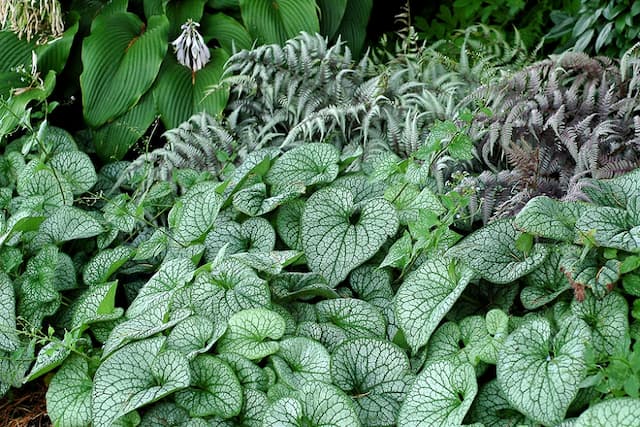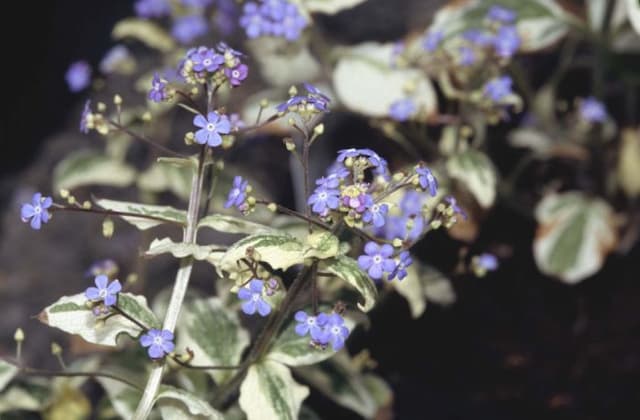Lungwort Pulmonaria 'Diana Clare'

ABOUT
Pulmonaria 'Diana Clare', commonly known as lungwort, is a perennial plant known for its striking foliage and lovely spring flowers. This variety features leaves that are heavily silvered, providing a luminous quality to the plant. The leaves are ovate or heart-shaped with a rough texture and emerge with a unique silver frosting that persists throughout the growing season, creating a shimmering effect in the garden. The lungwort produces clusters of delicate flowers that emerge in shades of violet-blue, creating a beautiful contrast with the silvered leaves. During the blooming period, the flowers can change color from pink to blue as they age, adding further intrigue to its display. These bell-shaped flowers are arranged in clusters on stems that rise above the foliage, providing a pop of color in early spring when not many other plants are in flower. As the season progresses, the silver foliage of the 'Diana Clare' lungwort remains an attractive feature in the garden, even after the flowers have faded. Its textured leaves can become a backdrop for other plants, or it can serve as a focal point in shade gardens or woodland settings. The visual appeal of 'Diana Clare' lungwort makes it a favored choice for gardeners looking to add both foliage interest and early-season blooms to their shady garden spots.
About this plant
 Names
NamesFamily
Boraginaceae.
Synonyms
Lungwort, Bethlehem Sage, Spotted Dog.
Common names
Pulmonaria 'Diana Clare'
 Toxicity
ToxicityTo humans
Lungwort, including the Pulmonaria 'Diana Clare' variety, is not known to be toxic to humans. There is no widely recognized concern for poisoning from ingesting Lungwort, and therefore, no specific symptoms of poisoning are generally associated with this plant.
To pets
Lungwort, including the Pulmonaria 'Diana Clare' variety, is not known to be toxic to pets. It is generally considered safe for dogs, cats, and other domestic animals. There should be no expected symptoms of poisoning from pets ingesting Lungwort as it is not recognized as a poisonous plant to pets.
 Characteristics
CharacteristicsLife cycle
Perennials
Foliage type
Semi-deciduous
Color of leaves
Mixed
Flower color
Blue
Height
1 foot (30 cm)
Spread
1-2 feet (30-60 cm)
Plant type
Herb
Hardiness zones
3
Native area
Europe
Benefits
 General Benefits
General Benefits- Attracts Pollinators: Pulmonaria 'Diana Clare' produces flowers that are favored by bees and butterflies, helping to support local ecosystems.
- Shade Tolerant: This variety thrives in partial to full shade, making it ideal for woodland gardens or shaded areas where many other plants struggle.
- Spring Interest: With its early-spring blooms, Pulmonaria 'Diana Clare' provides color and interest to gardens at a time when few other plants are flowering.
- Low Maintenance: Once established, it requires minimal care other than occasional watering during dry spells and removing old foliage.
- Groundcover: Its spreading habit helps to cover bare spots in the garden and suppress weeds, reducing garden maintenance.
- Drought Resistant: Pulmonaria 'Diana Clare' is relatively drought-tolerant once established, making it suitable for drier gardens or regions.
- Decorative Foliage: Even when not in bloom, the plant’s silver-spotted leaves remain an attractive feature throughout the growing season.
 Medical Properties
Medical Properties- This plant is not used for medical purposes.
 Air-purifying Qualities
Air-purifying QualitiesThis plant is not specifically known for air purifying qualities.
 Other Uses
Other Uses- The Lungwort plant 'Diana Clare' can be used as a natural dye source, providing subtle hues to textiles and fabrics when used in traditional dyeing processes.
- In a wildlife garden, Lungwort serves as an early source of nectar for bees and butterflies, particularly in regions with long winters when few other flowers are available.
- The decorative leaves of Pulmonaria 'Diana Clare' can be used in floral arrangements as a foliage contrast due to their unique spotted and silvered patterns.
- Lungwort can be planted under trees and shrubs as a living mulch to help retain soil moisture and suppress weed growth.
- The plant is suitable for creating a themed "moonlight garden" as its silvery foliage reflects moonlight, creating a soft glow during the evening hours.
- Lungwort can be used as an educational tool in gardens or schools to teach about early bloomers and the importance of pollinators in springtime ecosystems.
- As a resilient ground cover, Pulmonaria 'Diana Clare' can help stabilize soil on slopes or areas prone to erosion.
- Due to its attractive foliage, Lungwort can be used in container gardening, offering visual interest before and after the flowering period.
- The plant can play a role in sensory gardens, providing a variety of textures from its rough leaves and soft flowers for tactile exploration.
- In large-scale landscaping, Lungwort can be used to create patterns or borders when planted in mass due to its uniform growth habit and leaf variegation.
Interesting Facts
 Feng Shui
Feng ShuiThe Lungwort is not used in Feng Shui practice.
 Zodiac Sign Compitability
Zodiac Sign CompitabilityThe Lungwort is not used in astrology practice.
 Plant Symbolism
Plant Symbolism- Hope: Pulmonaria 'Diana Clare', commonly known as Lungwort, often symbolizes hope due to its resilience and early spring blooms, suggesting the renewal of life.
- Healing: The medicinal history of Lungwort, particularly its use in treating lung diseases, has lent this plant a symbolic meaning of healing and therapeutic properties.
- Devotion: The Lungwort's spots have been associated with the tears of the Virgin Mary in Christian symbolism, representing a mother's devotion.
- Longevity: With its robust nature and ability to thrive in challenging environments, Lungwort represents long life and persistence.
 Water
WaterThe Lungwort 'Diana Clare' should be watered deeply once a week, providing about 1 gallon of water per plant. During hot or dry spells, increase watering frequency to maintain evenly moist soil, without allowing it to become waterlogged. In the winter and cooler months, reduce watering as the plant requires less moisture. It is crucial to water the plant at its base, avoiding wetting the foliage to prevent the spread of disease.
 Light
LightLungwort 'Diana Clare' thrives best in partial shade to full shade conditions. This plant prefers a spot that is shielded from the harsh afternoon sun, which can scorch its leaves. Ideally, situate the plant where it can receive gentle morning light and then be protected by the shade of taller plants or a structure as the day progresses.
 Temperature
TemperatureLungwort 'Diana Clare' is hardy and can tolerate a temperature range from around 20°F to 80°F. However, the ideal growing temperature for this plant is between 60°F and 70°F. It is not recommended to expose the plant to temperatures below 20°F or above 80°F for extended periods, as it may damage the plant or inhibit its growth.
 Pruning
PruningPrune Lungwort 'Diana Clare' to remove any spent flowers or damaged leaves to encourage a tidier plant and possibly a second bloom. Light pruning can be done after the first flowering in late spring or early summer. Prune back heavily in late winter or early spring to help rejuvenate the plant and promote vigorous growth in the coming season.
 Cleaning
CleaningNot needed
 Soil
SoilLungwort 'Diana Clare' thrives in organically rich, well-draining soil with a pH of around 6.5 to 7.0. A mix of garden loam, compost, and leaf mold or peat moss can create an ideal environment, balancing moisture retention and aeration.
 Repotting
RepottingLungwort 'Diana Clare' does not frequently require repotting; it can be done every 2-3 years or when the plant outgrows its container, to provide fresh soil and room for growth.
 Humidity & Misting
Humidity & MistingLungwort 'Diana Clare' prefers moderate humidity levels but is quite adaptable to different humidity conditions as long as it isn't too dry; no specific humidity level is necessary.
 Suitable locations
Suitable locationsIndoor
Place Lungwort 'Diana Clare' in bright, indirect light inside.
Outdoor
Keep Lungwort 'Diana Clare' in shade to partial sun outdoors.
Hardiness zone
4-8 USDA
 Life cycle
Life cycleLungwort 'Diana Clare' starts life as a seed, which germinates in moist, well-drained soil in partial to full shade. The seedlings develop into a rosette of leaves and gradually establish a deep root system. As the plant matures, it produces broad, silver-spotted leaves and, in early spring, sends up stems bearing pink-to-blue funnel-shaped flowers which attract pollinators. After flowering, seeds are produced and dispersed, either by wind or wildlife, to begin a new generation. In the summer, the plant enters a semi-dormant phase to conserve energy, especially important in hotter climates. Over time, the clumps may become crowded and can be divided in late summer or early autumn to rejuvenate growth and spread the plant.
 Propogation
PropogationPropogation time
Spring to Summer
Propogation: The Pulmonaria 'Diana Clare', commonly known as Lungwort, is typically propagated through division. This popular method is done in either spring or fall when the plant is not in active bloom. To propagate by division, carefully dig up the Lungwort, making sure to get as much of the root system as possible. Gently separate the plant into smaller clumps, ensuring that each clump has several healthy shoots and a portion of the root system. Replant the new divisions promptly, spacing them about 12 inches (approximately 30 centimeters) apart so each has sufficient space to grow. Water the new plants thoroughly to help establish them in their new location. This method allows for the quick establishment of new plants and is ideal for expanding the garden or sharing with fellow garden enthusiasts.









